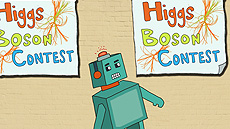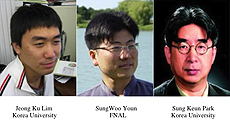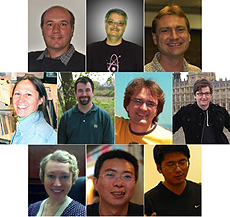|
Thursday, July 17
11 a.m.
Intensity Frontier Seminar Series - WH8XO
Speaker: Flavio Cavanna, Yale University
Title: Detection of 0-Pion CC Neutrino Interactions in LArTPC with ArgoNeuT
2:30 p.m.
Theoretical Physics Seminar (NOTE LOCATION) - WH3NE
Speaker: David J.E. Marsh, Perimeter Institute
Title: Cosmological Constraints on Ultra-light Axions: Planck, the High-Z Universe and BICEP2
3:30 p.m.
DIRECTOR'S COFFEE BREAK - 2nd Flr X-Over
Friday, July 18
3:30 p.m.
DIRECTOR'S COFFEE BREAK - 2nd Flr X-Over
4 p.m.
Joint Experimental-Theoretical Physics Seminar - One West
Speaker: Sabine Lammers, Indiana University
Title: Vector Boson Fusion Production at ATLAS
Click here for NALCAL,
a weekly calendar with links to additional information.
Ongoing and upcoming conferences at Fermilab |
|
Thursday, July 17
- Breakfast: Canadian bacon, egg and cheese Texas toast
- Breakfast: Greek omelet
- Ranch hous steak sandwich
- Smart cuisine: sweet and sour apricot chicken
- Barbecue pork spareribs
- Rustic club flatbread sandwich
- Strawberry salad
- Beef and rice soup
- Chef's choice soup
- Assorted pizza by the slice
Wilson Hall Cafe menu |
|
Friday, July 18
Dinner
Closed
Wednesday, July 23
Lunch
- Greek meatballs with feta yogurt dressing
- Lemon couscous
- Baklava
Chez Leon menu
Call x3524 to make your reservation.
|
|
The machine learning community takes on the Higgs
 |
| Detecting new physics isn't quite like detecting cat videos — yet. Image: Sandbox Studio
|
Scientists have created a contest that invites anyone to use machine learning — the kind of computing that allows Facebook to spot your friends in photos and Netflix to recommend your next film — to search for the Higgs boson.
More than 1,000 individuals have already joined the race. They're vying for prizes up to $7,000, but according to contest organizers, the real winner might be the particle physics community, whose new connections with the world of data science could push them toward new methods of discovery.
The contest works like this: Participants receive data from 800,000 simulated particle collisions from the ATLAS experiment at the Large Hadron Collider. The collisions can be sorted into two groups: those with a Higgs boson and those without.
The data for each collision contains 30 details — including variables such as the energy and direction of the particles coming out of it. Contestants receive all of these details, but only 250,000 of the collisions are labeled "Higgs" or "non-Higgs."
They must use this labeled fraction to train their algorithms to find patterns that point to the Higgs boson. When they're ready, they unleash the algorithms on the unlabeled collision data and try to figure out where the Higgs is hiding.
Contestants submit their answers online to Kaggle, a company that holds the answer key. When Kaggle receives a submission, it grades, in real time, just a portion of it — to prevent people from gaming the system — and then places the contestant on its public leaderboard.
At the end of the Higgs contest, Kaggle will reveal whose algorithm did the best job analyzing the full dataset. The top three teams will win $7,000, $4,000 and $3,000. In addition, whoever has the most useable algorithm will be invited to CERN to see the ATLAS detector and discuss machine learning with LHC scientists.
Read more
—Kathryn Jepsen
|
Baptisia stem
 |
| Baptisia stem recently bloomed on the Fermilab prairie. Photo: Barb Kristen, PPD
|
|
Tackling the physical sciences
From The Open Notebook, July 15, 2014
Imagine that you are a salesperson tasked with selling a special product. Most people know very little about the product, and many have had a bad experience with similar items. People can't see what you are selling, and it is unlikely to impact their lives immediately.
Such is the plight of the reporter who covers the physical sciences. Science writers on this beat know its hazards, from having to describe the intricacies of quantum gravity to dealing with readers who hated chemistry in high school. Yet some journalists are still compelled accept the challenge, often driven by a love for a particular scientific field.
"It's a very important role," says Kathryn Jepsen, editor-in-chief of Symmetry, a magazine that covers particle physics and is published by the Fermilab and SLAC national laboratories. Physicists, chemists and mathematicians devote their lives to research, just like their biological science counterparts. And research that is funded by taxpayers deserves coverage, no matter the discipline. "It's really only going to be worth it if the science can be translated back to the public, to the rest of the world," she says.
Read more
|
A new, improved Large Hadron Collider
From The Financial Times, July 11, 2014
The Large Hadron Collider will restart its discovery programme early in 2015, after a two-year shutdown during which Cern has almost doubled the operating power of its $8bn atom smasher.
"There is a new buzz about the laboratory and a real sense of anticipation," says Cern director-general Rolf-Dieter Heuer. "Much work has been carried out on the LHC and it's effectively a new machine, poised to set us on the path to new discoveries."
Read more
|
|
Measuring a fractional charge
 |
| At left is the apparatus used by Robert Millikan and his student to measure the charge of the electron in the early 20th century. At right is the apparatus used by more than 300 physicists — including students — to measure the charge of the top quark in the early 21st century.
|
Disponible en español
In 1909, Robert Millikan and Harvey Fletcher performed a Nobel Prize-winning experiment that showed that elementary particles always have a specific amount of electric charge and that fractional charges do not exist. Now, a century later, we measure fractional charges.
To be fair, in Millikan's time, there were few known particles to work with. His experiment was done using electrons, although by inference the result also applies to protons. Particles called quarks were unknown to Millikan and are quite different from electrons. They should have charges of either +2/3 or -1/3 times that of the electron.
We say "should have charges" because quarks are (nearly) always found inside hadrons, such as protons and neutrons, where they are bound very tightly to other quarks. Unlike electrons, you can't find just one and measure it. Consequently, the charge assignments for quarks are inferred from the charges of hadrons and from our model of the various quarks that are inside hadrons.
The top quark is a little different though. Because of its large mass, the top quark decays before becoming bound up in a hadron. Electrical charge being conserved, we know that if we identify the particles that a top quark decays into and add up their electrical charges, then we have the charge of the top quark.
The tricky part is identifying which particles measured at the Tevatron are the ones that come from the decaying top quark. There is so much energy in Tevatron collisions that the available energy E results in the mc2 of many particles, not all of which are the products of top quark decay.
In "lepton + jets" events, there is always a very energetic electron or muon, which very likely is the product of the top decay. The other "particle" produced in that top quark decay is a jet, a narrow spray of particles that are all going in the same direction. They are produced from the decays of a single particle; in the Standard Model, that progenitor is a bottom quark. To determine the charge of the progenitor, we count the charges of all the particles in a jet. Because the more energetic particles are more likely to reflect the progenitor's charge, we count their charges more heavily in our summation.
The prediction of the Standard Model is quite clear: the top quark's charge should be positive and 2/3 times that of the electron. However, it is still possible that the top quarks that are produced by the Tevatron are not what we think they are. There is some possibility that it is instead an exotic particle with a negative charge 4/3 times that of the electron.
To check on this possibility, the DZero collaboration used these methods to measure the electrical charge of the top quark. Because there are only two possible answers, +2/3 and -4/3, the primary result is to determine which of the two options is more likely and how much more likely it is. We find with a very high level of confidence that the +2/3 answer is the right one. The probability that an exotic top quark could have given our result is only one in about 16 million. As far as its electric charge is concerned, the top quark looks just as predicted in the Standard Model of elementary particles.
—Leo Bellantoni
 |
| These DZero members all made significant contributions to this result. |
 |
| The Tevatron is no longer running, but the river of results it produces still is. The DZero collaborators who presented DZero or Tevatron results at the International Conference of High Energy Physics recently in Valencia, Spain, are: Top row, from left: Gregorio Bernardi (LPNHE/Paris), Don Lincoln (Fermilab), Rick Van Kooten (U Indiana). Middle row, from left: Marj Corcoran (Rice U), Ken Herner (Fermilab), Oleg Brandt (U Göttingen), Christian Schwannenberger (U Manchester). Bottom row, from left: Regina Demina (U. Rochester), Hengni Li (U Virginia), Siqi Yang (USTC, China). |
|
|